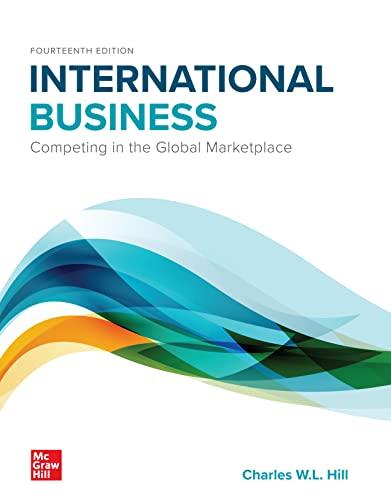Back in 1970, companies in the United States assembled more than 15 million bicycles a year. Then
Question:
Back in 1970, companies in the United States assembled more than 15 million bicycles a year. Then globalization took hold. As cross-border tariffs tumbled, U.S. bicycle companies increasingly outsourced the manufacture of component parts and final assembly to other countries where production costs were significantly lower. By far the biggest beneficiary of this trend was China. In 2018, about 95 percent of the 17 million bicycles sold in the United States were assembled in China. China also produced more than 300 million components for bikes, such as tires, tubes, seats, and handlebars—
or about 65 percent of U.S. bike component imports. Most American bicycles companies that remained in business focused on the design and marketing of products that were made elsewhere. American consumers benefited from lower prices for bikes.
One exception to the outsourcing trend was Detroit Bikes, a company started in 2013 by Zakary Pashak in Detroit, Michigan. Pashak was partly motivated by a desire to bring some manufacturing back to Detroit, a city that had suffered from the decline of automobile manufacturing in Michigan. He reasoned there would be lots of manufacturing expertise in Detroit that would help him to get started. While that was true, ramping up production was difficult. Pashak noted that “when you send a whole industry overseas, it’s hard to bring it back.” One problem: Even the most basic production equipment was hard to find, and much of it wasn’t made in the United States. Another problem: While the company figured out how to assemble bicycles in the United States, a lot of the components could not be sourced locally. There simply were no local suppliers, so components had to be imported from China.
Despite these headwinds, by 2019 Pashak had grown his business to about 40 people and was gaining traction.
Things started to get complicated in 2018 when President Donald Trump slapped 25 percent tariffs on many imports from China, including bikes and component parts. Trump’s actions upended a decades-long worldwide trend toward lower tariffs on cross-border trade in manufactured goods and started a trade war between the United States and China. For Detroit Bikes, this was a mixed blessing. On the one hand, because assembly was done in Detroit, the tariffs on imported finished bikes gave Pashak’s company a cost advantage. On the other hand, the cost of imported components jumped by 25 percent, raising the production costs of his bikes and canceling out much of that advantage.
In response, Pashak started to look around to see if parts made in China could be produced elsewhere. He looked at parts made in Taiwan, which aren’t subject to tariffs, and Cambodia, which benefits from low labor costs. It turns out, however, that switching to another source is not that easy. It takes time for foreign factories to ramp up production, and there may not be enough capacity outside of China to supply demand. There is also considerable uncertainty over how long the tariffs will remain in place. Many foreign suppliers are hesitant to invest in additional capacity for fear that if the tariffs are removed down the road, they will lose their business to China. For example, while Taiwan’s U.S. bike exports jumped almost 40 percent to over 700,000 units in 2019, Taiwan’s manufacturers were holding back from expanding capacity further because they feared orders might dwindle if the trade war between the United States and China ended. Instead, they raised their prices, thereby canceling much of the rationale for shifting production out of China in the first place. Due to issues like this, a survey by Cowen & Co at the end of 2019 found that only 28 percent of American companies had switched their supply chains away from China, despite the higher tariffs. Of those, just a fraction had managed to switch 75 percent or more of their supply chain to a different country.
Faced with such realities, Pashak has contemplated other strategies for dealing with the disruption to his supply chain. One option he has considered is bringing in Chinese parts to Canada where they do not face a tariff, shipping his American-made frames up to Canada, putting the parts on them, and then importing them back into the United States. While this would reduce his tariff burden, it would be costly to implement, and any advantages would be nullified if the Chinese tariffs are removed.
Faced with this kind of complexity and uncertainty, the easiest solution for many companies, in the short run, is to raise prices. Pashak is unsure if he will do this, but many other companies say they have no choice.
Case Discussion Questions 1. Did the outsourcing of bike production to China and other countries during the 1980–2018 period benefit American consumers?
Did it benefit American bike producers?
2. Why did Zakary Pashak want to bring bike manufacturing back to the United States in 2013? Was this an economically rational strategy? What problems did he confront when trying to do this?
3. How did the imposition of a 25 percent tariff on imports from China by the Trump administration impact Detroit Bikes? Did these tariffs benefit Detroit Bikes? Did they benefit American consumers? What were the unintended consequences of these tariffs?
4. What does this case tell you about
(a) the benefits of international trade and globalization,
(b) the challenges associated with insourcing manufacturing, and
(c) the intended and unintended consequences of import tariffs?
Step by Step Answer:

International Business Competing In The Global Marketplace
ISBN: 9781260387544
14th Edition
Authors: Charles Hill





